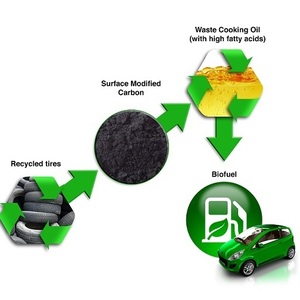Researchers use waste tires as new biodiesel catalyst ingredient

Image: Oak Ridge National Laboratory
August 10, 2017
BY Ron Kotrba
Researchers at Oak Ridge National Laboratory in Tennessee have demonstrated that carbon from waste tires can be functionalized with sulfonic acid to catalyze esterification of oleic acid or a mixture of fatty acids into biodiesel.
“Waste tires were converted to hard carbon, then functionalized with catalytically active -SO3H groups on the surface through an environmentally benign process that involved the sequential treatment with L-cysteine, dithiothreitol and H2O2,” states the abstract of a publication, titled “Novel Acid Catalysts from Waste-Tire-Derived Carbon: Application in Waste-to-Biofuel Conversion,” published Aug. 1 in Chemistry Select. “When benchmarked against the same waste-tire-derived carbon material treated with concentrated sulfuric acid at 150 degrees Celsius, similar catalytic activity was observed. Both catalysts could also effectively convert oleic acid or a mixture of fatty acids and soybean oil to usable biofuels at 65 C and 1 atm without leaching of the catalytic sites.”
The study was conducted with collaborators Wake Forest University and Georgia Institute of Technology. ORNL co-author Parans Paranthaman said the patent-pending approach provides an environmentally benign pathway for inexpensive products from waste tires, and is a step toward large-scale biofuel production.
Advertisement
Advertisement
Previous ORNL studies have shown carbon powders can be used in developing lithium-ion, sodium-ion and potassium-ion batteries and supercapacitors.
Advertisement
Advertisement
Related Stories
Biodiesel capacity in the U.S. and Canada dipped slightly stable in 2024, with several renewable diesel producers reporting headwinds and lower margins alongside a drove of SAF projects in various stages of development.
The IEA’s Task 39 group has new research regarding the development and status of the sustainable aviation fuel industry.
The U.S. EPA on Nov. 16 released updated RIN data, reporting that nearly 2.11 billion RINs were generated under the RFS in October, up from 1.81 billion generated during the same month of last year.
Conestoga to host SAFFiRE cellulosic ethanol pilot plant
Conestoga Energy and SAFFiRE Renewables LLC announced on Nov. 16 their agreement for Conestoga to host SAFFiRE’s cellulosic ethanol pilot plant at Conestoga’s Arkalon Energy ethanol facility in Liberal, Kansas.
Officials at Calumet Specialty Products Partners L.P. discussed the company’s proposed plans to boost sustainable aviation fuel (SAF) production at its Montana Renewables biorefinery during third quarter earnings call, held Nov. 9.
Upcoming Events










